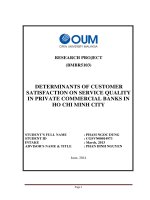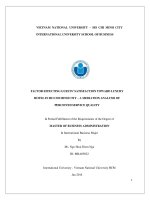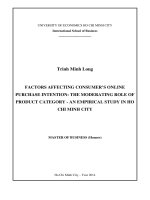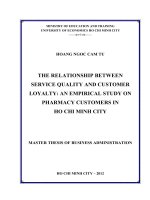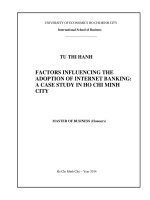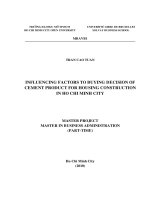Determinants of consumer satisfaction on service quality in private comercial banks in ho chi minh city
Bạn đang xem bản rút gọn của tài liệu. Xem và tải ngay bản đầy đủ của tài liệu tại đây (1.09 MB, 73 trang )
Page 1
RESEARCH PROJECT
(BMBR5103)
DETERMINANTS OF CUSTOMER
SATISFACTION ON SERVICE QUALITY
IN PRIVATE COMMERCIAL BANKS IN
HO CHI MINH CITY
STUDENT’S FULL NAME : PHAM NGOC DUNG
STUDENT ID : CGSVN00014973
INTAKE : March, 2013
ADVISOR’S NAME & TITLE : PHAN DINH NGUYEN
June, 2014
Page 2
Advisor’s assessment
Advisor’s signature
Page 3
ACKNOWLEDGMENTS
I would like to express my deeply sincere gratitude to my teacher, Dr. Phan Dinh
Nguyen, for his valuable guidance and advice on effective method. His
professional research understanding helps me and my friends recognize the
research method thoroughly and we had experienced actual process. His comments
and meaningful suggestions were contributed great help for my completion of this
research.
In addition, I would like to special express my thanks to all of my classmates, my
colleagues, my friends who are working in some banks in Ho Chi Minh City: Ms
Ngo Tran Doan Trinh (VietBank), Mr. Ky Minh Thien (Vietcombank), Mr Hoang
Minh Hung (GPbank), Mrs Nguyen Thi Chau (Eximbank)….for their support and
encouragement during the time I was doing my research. And thank you to all
customers who had spent precious time to answer the questionnaire for my topic.
Ho Chi Minh City, Vietnam
September 6th 2014
Pham Ngoc Dung
Page 4
Table of Contents
Advisor’s assessment 2
Acknowledgements 3
List of Tables and figures 6
List of Abbreviations 6
Abstract 8
CHAPTER 1: INTRODUCTION 10
1.1 Problem statement 10
1.2 Research Objectives 11
1.3 Research questions 12
1.4 Scope and Methodology of Research 12
1.5 Research structure 12
CHAPTER 2: LITERATURE REVIEW 14
2.1Theoretical literature 14
2.1.1 Quality 14
2.1.2 Service 14
2.1.3 Service Quality 15
2.1.4 Customer Satisfaction 16
2.1.5 Relationship between Service Quality and Customer Satisfaction 18
2.2 Service Quality Research Models 19
CHAPTER 3: RESEARCH METHODOLOGY 21
3.1 Data sources 21
3.2 Methods of data analysis 21
3.2.1 For objective No.1 21
3.2.2 For objective No.2 21
a. Scale 21
Page 5
b. Analysis steps to achieve objective 2 22
3.2.3 For objective No.3 23
3.3 Research Framework 24
3.4 Research Hypotheses 24
CHAPTER 4: BUSINESS SITUATION AND PERFORMANCE OF
PRIVATE COMMERCIAL BANKS IN HCMC 25
4.1. General overview of the activities of private commercial banks that have
headquater in HCMC 25
4.2. The basic existence and limitations 27
4.3. A number of reasons 29
CHAPTER 5 : EMPIRICAL RESULTS AND DISCUSSION 32
5.1 Results of interviews about the customer personal information 32
5.2. Checking the relevence of the scale 33
5.3. Exploratory factor analysis 34
5.4 Regression Results 41
CHAPTER 6 : SOME POSSIBLE SOLUTIONS ARE GIVEN TO
IMPROVE CUSTOMER SATISFACTION ON SERVICE QUALITY OF
THE PRIVATE BANKS IN HCMC 47
6.1 Conclusion 47
6.2 Policy Recommendation 48
REFERENCES 53
APPENDIX 56
Appendix A – Questionnaire Survey 56
Questionnaire Survey (English) 56
Questionnaire Survey (Vietnamese) 61
Appendix B 66-73
Page 6
List of Tables and figures
Table 1.1: Result of collected samples 11
Figure 1 : Research Framework 24
Table 4.1: The overview about business activities of private banks 25
Table 4.2: The operations for mobilizing and lending capital of the banks 26
Table 5.1: Demographic profile of the sample respondents 32
Table 5.2 Rotated Component matrix 35
Table 5.3 : Component score coeficient matrix 41
Figure 2: Research model 42
Table 5.4 : Regression analysis 42
Table 5.5 : Correlations testing results 43
Table 5.6 : Coefficients
a
44
Table 5.7 : The order of the impact of these factors to customer satisfaction 46
Page 7
List of Abbreviations
HCMC Ho Chi Minh City
ACB Asean Commercial Bank
OCB Ocean Commercial Bank
HDBank House Development Bank
SCB SaiGon Commercial Bank
ABBank An Binh Bank
Page 8
ABSTRACT
The banking industry is rapidly changing. This is the sector mainly depends on
the trust and loyalty of the customer. Therefore, in order to succeed and survive
in the current market, banking managers need to design strategies to enhance
service quality to satisfy customers better than competitors.
This study was conducted to identify the relationship between customer
satisfaction, service quality of private commercial banks in Ho Chi Minh City
(HCMC). It attempts to discover the impact of service quality on customer
satisfaction in private commercial banks in HCMC. Five dimensions in service
quality (SERVPERF) such as tangibles, reliability, responsiveness, assurance and
empathy (Cronin and Taylor, 1992) were used to evaluate satisfaction with the
quality of banking services. A Three-part questionnaire was developed as the
instrument to collect data, using the five-point Likert scale, ranging from strongly
disagree (1) to strongly agree (5). The structured questionnaire consists five (05)
questions for Reliability, five (05) questions for Responsiveness, five (05)
questions for Assurance, five (05) questions for Empathy and four (04) questions
for Tangibility and five (05) for Customer satisfaction with relevant personal
information. There were 269 usable responses of 390 customers who received the
questionnaire. These customers were from five (05) private commercial banks in
HCMC, such as : ABBank, OCB, VietABank, HDBank and SouthernBank,
which approximates to 38,46% of the total number of banks that have
headquarters in the area. Data has been analysed by using SPSS software
(version: 16) and combining the Exploratory Factors Analysis (EFA) with Binary
Logistic Model .
Page 9
Result of the study showed service quality dimensions is crucial for customer
satisfaction in private commercial banks in HCMC and helps managers of
commercial banks in HCMC taking measures to improve the level of satisfaction
for customers in oder to keep old customers and attract new customers such as :
variety of banks products and services, promote marketing activities and improve
the capacity, skills of staff.
Page 10
CHAPTER 1: INTRODUCTION
1.1 Problem statement
The social is increasingly developing, life quality of people is increasingly high,
so the consumer demand for the products that they choose is also higher.
Improving product and services quality is competitive trends that private
commercial banks in Vietnam must pay attention in order to increase market
share and face many challenges in term of competition, especially when large
foreign financial groups and banks entered Vietnam.
Being aware of the importance of customer satisfaction, Vietnam banking system
in general and the private commercial banks in Ho Chi Minh City in particular
need to improve their operations as well as strengthen their images in customers’
eyes in order to be able to capture market shares, develop faster and have position
in the market. The problem that banks try their best to fulfill is how to give
customers the best satisfaction in order to meet their needs when using bank’s
products and services. The study “Determinants of customer saisfaction on
service quality in private commercial banks in HCMC” is not out of this purpose
which aims to enhance customer satisfactions for improving the service quality of
the private commercial banks in HCMC in the context of financial liberalization
and globalization.
At the end of May, 2014 there are 13 private commercial banks that have
headquarters in HCMC, such as : Eximbank, ACB, Sacombank, SaigonBank,
NamAbank, VietcapitalBank, OCB, ABBank, DongAbank, VietABank, SCB,
HDBank and SouthernBank. Three (03) of them such as ACB, Eximbank,
Sacombank which have been rated as good domestic banks for the last years by
various domestic and international financial publications based on theirs financial
situation, operation scale, long-term vision, strategy, market positioning, service
quality, analysts’ assessments. The remaining banks (10 banks) of them have
Page 11
been rated as small banks by charter capital, total assets, financial situation and
analysts’ assessments. Due to limited conditions to carry out this study, I only
selected customers of 5 small-scale banks for my study, to ensure that collected
samples are representative of the whole. These 05 small-scale banks are OCB,
Vietbank, ABBank, HDBank, Southernbank. Number of samples was sent and
eligible and to be presented through Table 1.
Table 1 :
Results of collected samples
Criteria
Number of samples was
sent
Number of samples
was eligible
Rate
OCB
90
65
72,22%
VietAbank
70
40
57,14%
ABBank
80
67
83,75%
HDbank
90
58
64,44%
Southernbank
60
39
65,00%
Total
390
269
68,97%
1.2 Research Objectives
The main objectives of this research are to identify factors affecting the level of
customer satisfaction on service quality in order to better serve customers, also
enhance the competitiveness and business efficiency of private commercial banks
in HCMC.
Specific objectives are as follows :
1. To consider the level of customer satisfaction on service quality of
commercial banks in HCMC;
2. To identify the impact of service quality on customer satisfaction of the
private commercial banks in HCMC;
Page 12
3. To give some possible solutions to improve customer satisfaction on service
quality of the private commercial banks in HCMC;
1.3 Research questions
Specifically, the research aims to address the following questions:
1. How are business situation and business performance of private commercial
banks in HCMC?
2. What are are the most important dimensions of service quality that affect
customer satisfaction in commercial banks in HCM city?
3. What should the private commercial banks in HCMC do in order to improve
the level of satisfaction of existing customers and attract new customers?
1.4 Scope and Methodology of Research
- The scope of the study is direct customers that have used the products and
services of 05 following banks : OCB, Vietbank, ABBank, HDBank,
Southernbank
- The variables included in this study are : Tangible, Reliability, Responsiveness,
Assurance and Empathy are independent variables. And customer satisfaction is
dependent variable.
- The determinants of customer satisfaction is estimated from the SERVPERF
model by Cronin and Taylor (1992) to fit the banking market in Vietnam through
SPSS 16 software. The primary data and the secondary data are used to fulfill the
proposed research objectives.
1.5 Research structure
The study is organized in three chapters such as
Chapter 1 : the above introduction.
Page 13
Chapter 2: This part reviews theoretical literature and research model of
service quality.
Chapter 3: The study identifies and describes the sources of data,
methods of data analysis, research framework will be used.
Chapter 4: Business situation and business performance of private
commercial banks in HCMC.
Chapter 5: The impact of service quality on customer satisfaction of the
private commercial banks in HCMC.
Chapter 6: Some possible solutions are given to improve customer
satisfaction on service quality of the private commercial banks in HCMC
Page 14
CHAPTER 2: LITERATURE REVIEW
In this chapter, section 2.1 reviews key theories that are relevant of service
quality and following this, section 2.2 introduces the service quality models
which is used to measure service quality to fit private commercial banks in HCM
city.
2.1 Theoretical literature
2.1.1 Quality :
Quality is one of the things that consumers look for in an offer, which service
happens to be one (Solomon 2009, p. 413). Quality can also be defined as the
totality of features and characteristics of a product or services that bear on its
ability to satisfy stated or implied needs (Kotler et al., 2002, p. 831). Therefore,
quality is very important to specify needs & wants of customer and design the
service to meet these requirements.
2.1.2 Service :
- In order for a company’s offer to reach the customers there is a need for
services. These services depend on the type of product and it differs in the various
organizations.
- Service can be defined in many ways depending on which area the term is being
used. An author defines service as “any intangible act or performance that one
party offers to another that does not result in the ownership of anything” (Kotler
& Keller, 2009, p. 789).
- Giving a comprehensive definition of service, Gronroos (1990) pointed out: A
service is an activity or series of activities of more or less intangible nature that
normally, but not necessarily, take place in interactions between the customer and
service employees and/or systems of the service provider, which are provided as
solutions to customer problems. (p. 21)
Page 15
- In all, service can also be defined as an intangible offer by one party to another
in exchange of money for pleasure.
2.1.3 Service Quality :
- Organizations operating within the service sector consider service quality to be
a strategic component of their marketing plan (Spathis et al., 2004). Through
service quality, organizations can reach a higher level of service quality, a higher
level of customer satisfaction, and can maintain a constant competitive advantage
(Meuter et al., 2000)
- Service quality is defined as “the consumer's overall impression of the relative
inferiority/superiority of the organization and its services” (Bitner & Hubber,
1994, p. 77).
- Service quality is an important tool to measure customer satisfaction (Hazlina et
al., 2011). The studies of Lee et al. (2000); Gilbert and Veloutsou (2006);
Sulieman (2011) and Buttle (1996) suggest service quality leads to customer
satisfaction.
- In the changing banking scenario of 21st century, the banks had to have a vital
identity to provide excellent services. Banks nowadays have to be of world-class
standard, committed to excellence in customer’s satisfaction and to play a major
role in the growing and diversifying financial sector (Guo et al., 2008). There has
been a remarkable change in the way of banking in the last few years. Customers
have also accurately demanded globally quality services from banks. With
various choices available, customers are not willing to put up with anything less
than the best. Banks have recognized the need to meet customer’s aspirations.
Consequently service quality is a critical motivating force to drive the bank up in
the high technology ladder. Banking industry is a demand driven industry, which
constitute an important part of the service industry (Newman & Cowling, 1996).
Banks have to redefine their corporate image to that emphasizes service quality
since it provides many advantages to a company such as allowing the company to
Page 16
differentiate itself from its competitors by increasing sales and market shares,
providing opportunities for cross selling, improving customer relations thus
enhancing the corporate image, reliability, responsiveness, credibility and
communication results in the satisfaction and retention of customers and
employee, thus reducing turnover rate (Newman, 2001).
2.1.4 Customer Satisfaction:
- Customer satisfaction is one of the most important concepts for most marketers
and consumers (Jamal, 2004). Customer satisfaction has been a subject of great
interest to organizations and researchers alike. The principal objective of
organizations is to maximise profits and to minimise cost. Profit maximisation
can be achieved through increase in sales with lesser costs. One of the factors that
can help to increase sales is customer satisfaction, because satisfaction leads to
customer loyalty (Wilson et al., 2008, p. 79), recommendation and repeat
purchase.
- Some authors stated that there is no specific definition of customer satisfaction,
and after their studies of several definitions they defined customer satisfaction as
“customer satisfaction is identified by a response (cognitive or affective) that
pertains to a particular focus (i.e. a purchase experience and/or the associated
product) and occurs at a certain time (i.e. post-purchase, post-consumption)”.
(Giese & Cote, 2000, p. 15) This definition is supported by some other authors,
who think that consumer’s level of satisfaction is determined by his or her
cumulative experience at the point of contact with the supplier (Sureshchander et
al., 2002, p. 364). It is factual that, there is no specific definition of customer
satisfaction since as the years passes, different authors come up with different
definitions. Customer satisfaction has also been defined by another author as the
extent to which a product’s perceived performance matches a buyer’s
expectations (Kotler et al., 2002, p. 8). According to Schiffman & Karun (2004)
Customer satisfaction is defined as “the individual’s perception of the
performance of the products or services in relation to his or her expectations”
Page 17
(Schiffman & Karun 2004, p. 14). In line with Tsoukatos and Rand (2006),
customer satisfaction is a key to long-term business success. To protect or gain
market shares, organizations need to outperform competitors by offering high
quality product or service to ensure satisfaction of customers. In proportion to
Magesh (2010), satisfaction means a feeling of pleasure because one has
something or has achieved something. It is an action of fulfilling a need, desire,
demand or expectation. Customers compare their expectations about a specific
product or services and its actual benefits. As stated by Kotler & Armstrong,
(2010), satisfaction as a person’s feelings of pleasure or disappointment resulting
from the comparison of product’s perceived performance in reference to
expectations. Customer’s feelings and beliefs also affect their satisfaction level.
Along with Zeithaml (2009), satisfaction or dissatisfaction is a measure or
evaluation of a product or service’s ability to meet a customer’s need or
expectations. Razak et al. (2007) also reported that overall satisfaction is the
outcome of customer’s evaluation of a set of experiences that are linked with the
specific service provider. It is observed that organization’s concentration on
customer expectations resulted into greater satisfaction. If the customers of an
organization are satisfied by their services the result is that, they will be loyal to
them and consequently be retained by the organization, which is positive for the
organization because it could also mean higher profits, higher market share, and
increasing customer base (Karatepe et al., 2005). Customer satisfaction has
become important due to increased competition as it is considered very important
factor in the determination of bank’s competitiveness (Berry et al., 2002).
Continuous measurement of satisfaction level is necessary in a systematic manner
(Chakravarty et al., 1996). Because satisfied customer is the real asset for an
organization that ensures long-term profitability even in the era of great
competition. Cronin et al., (2000) mentioned in their study that satisfied customer
repeat his/her experience to buy the products and also create new customers by
communication of positive message about it to others. On the other hand,
Page 18
dissatisfied customer may switch to alternative products/services and
communicate negative message to others. Customer satisfaction is a set of feeling
or outcome attached with customer’s experience towards any product/ service
(Solomon, 1998). Hence, organizations must ensure the customer satisfaction
regarding their goods/services.
Summary, customer satisfaction could be the pleasure obtained from consuming
an offer. Regardless of whether these organizations provide goods or services,
they recognize that satisfied customers are the key to their success.
2.1.5 Relationship between Service Quality and Customer Satisfaction:
Quality and customer satisfaction have long been recognized as playing a crucial
role for success and survival in today's competitive market. Regarding the
relationship between customer satisfaction and service quality, Oliver (1993) first
suggested that service quality would be antecedent to customer satisfaction
regardless of whether these constructs were cumulative or transaction-specific. In
relating customer satisfaction and service quality, researchers have been more
precise about the meaning and measurements of satisfaction and service quality.
Satisfaction and service quality have certain things in common, but satisfaction
generally is a broader concept, whereas service quality focuses specifically on
dimensions of service (Wilson et al., 2008). Although it is stated that other factors
such as price and product quality can affect customer satisfaction, perceived
service quality is a component of customer satisfaction (Zeithaml & Bitner,
2003). As said by Wilson et al. (2008), service quality is a focused evaluation that
reflects the customer’s perception of reliability, assurance, responsiveness,
empathy and tangibility while satisfaction is more inclusive and it is influenced
by perceptions of service quality, product price and quality, also situational
factors and personal factors. The relationship between service quality and
customer satisfaction is becoming crucial with the increased level of awareness
among bank customers Demographic characteristics should be considered by the
bank managers to understand their customers (Sureshchander et al. 2002).
Page 19
2.2 Service Quality Research Models
There were various service quality models proposed and applied in different
context for the purpose of this study are such as : SERVQUAL and GAP model
by Parasuraman et al. (1985; 1991), SERVPERF by Cronin and Taylor (1992).
In 1985, Parasuraman, Zeithaml, and Berry introduced a new model of
service quality measurement by using the gap be between expected level of
service and dilivered level of sevice called “SERVQUAL”. Initially, it has ten
dimensions and later it got condensed to five dimensions like Tangibility,
Reliability, Assurance, Responsiveness and Empathy.
+ Tangibility: physical facilities, equipment, and appearance of personnel.
+ Reliability: ability to perform the promised service dependably and
accurately.
+ Responsiveness: willingness to help customers and provide prompt
service.
+ Assurance: knowledge and courtesy of employees and their ability to
inspire trust and Confidence.
+ Empathy: caring individualized attention the firm provides to its
customers.
Service quality is defined the model SERVQUAL as follows :
Service Quality = Customer Perceptions – Customer Expectations
Although SERVQUAL has been applied in many studies to assess service
quality, the reliability and validity of this instrument have been debated by
several authors, particularly the expectation dimensions. Carman (1990), for
Page 20
instance, argued that SERVQUAL is not applicable for the measurement of
service quality in every service industry since its five dimensions cannot be
generalized to all service industries. Teas (1993) also claimed that
SERVQUAL lacks the discriminatory validity that stems from the
expectation dimension scores because the respondents misunderstand the And
a new research instrument, SERVPERF is came up by Cronin and Taylor
(1992). This SERVPERF did not include the expectation dimension for the
measurement of service quality. Compared to SERVQUAL, SERVPERF is
considered a simpler instrument for measuring service quality since the
elimination of the expectation dimension makes the SERVPERF instrument
more efficient (Buttle, 1996). Boulding et al., (1993) also disagreed with the
consideration of the expectation dimensions, and stated that only perception
can be used to evaluate service quality. Thus, in this study, SERVPERF will
be used to measure service quality.
The SERVPERF scale consists of the five dimensions of service quality and
22 perception items excluding any consideration of expectations. Five
dimensions of the SERVPERF scale are tangibility, reliability, assurance,
responsiveness and empathy.
Service quality is defined the model SERVPERF as follows :
Service Quality = Customer Perceptions
The research instrument designed is based on the five dimensions of service
quality and the 22 service items of the SERVPERF model.
Page 21
CHAPTER 3: RESEARCH METHODOLOGY
Within this chapter, The study specifically identifies and describes the sources of
data, methods of data analysis, research framework to be used in the investigation
of three objective of this study.
3.1 Data sources
- The secondary data used for this topic were collected from documents, books,
newspapers, internet about 13 private commercial banks that have headquarters in
HCMC, and the information of the State Bank.
- The primary data were collected through personal interview from customers
were using banking services about their perceptions of the services quality
provided by five private commercial banks in HCMC in August 2014. The
structured questionnaire from selected customers consists five (05) questions for
Reliability, five (05) questions for Responsiveness, five (05) questions for
Assurance, five (05) questions for Empathy and four (04) questions for
Tangibility and five (05) for Customer satisfaction with relevant personal
information.
3.2 Methods of data analysis
3.2.1 For objective No.1 :
Topic was used secondary data from the business situation of 14 commercial
banks that have headquarter in HCMC through internet, some statistical reports of
Mr Nguyen Duc Lenh - Integrated Research Manager of the State Bank of
Vietnam – HCMC branch .
3.2.2 For objective No.2 :
a. Scale
Topic used SERVPERF scale to determine the factors that affect customer
satisfaction on service quality of private commercial banks in HCMC. All scales
Page 22
of concept were studied in scale model are multivariate and were measured with
5-point Likert-type scale ranging from 1- Strongly Disagree to 5- Strongly Agree.
b. Analysis steps to achieve objective 2 : Cronbach’s Alpha; Exploratory factor
analysis (EFA) and binary logistic model were used to analyse objective 2
b1) A Tool for Assessing the Reliability of Scales is Cronbach’s Alha
(Cronbach, 1951). Cronbach's alpha determines the internal consistency or
average correlation of items in a survey instrument to gauge its reliability. It
emphasized that reliability tests are especially important when derivative
variables are intended to be used for subsequent predictive analyses. If the scale
shows poor reliability, then individual items within the scale must be re-examined
and modified or completely changed as needed. One good method of screening
for efficient items is to run an exploratory factor analysis on all the items
contained in the survey to weed out those variables that failed to show high
correlation.
b2) Exploratory factor analysis (EFA): EFA is a technique that attempts to
determine the minimum number of continuous latent variables or factors that can
adequately describe the correlations among a set of observed variables. The
model is exploratory in the sense that it does not impose a structure on the
relationship between the observed variables and the continuous latent variables
but only specifies the number of continuous latent variables. The goal of
exploratory factor analysis is to find the smallest number of interpretable factors
that can adequately explain the correlations among a set of variables. It is
important that the factors be interpretable according to a recognized theory in
addition to the model fitting the data well. Exploratory factor analysis results can
be influenced by the set of variables included in the analysis. Therefore, it is
important that the set of variables be developed carefully with the aim of
measuring specific content areas prior to using EFA to study the intended
dimensionality. When used with such a set of variables, EFA can be a useful tool
Page 23
not only for understanding the dimensionality of a set of variables but also for
isolating variables that do not measure the dimensions well. EFA can be helpful
during pilot work in the development of a set of items. Structural diagram of the
multiplier variable described by the following equation :
Fi = Wi1X1 + Wi2X2 + Wi3X3+ + WiKXk
B3) Multiple Regression Analysis: Regression analysis examines the
simultaneous effects of several independent variables on a dependent variable
that is in interval scale. Therefore, it was applied to show us how much of the
variance in the customer satisfaction is explained by the set of service quality
factors.
For objective No.3 :
Analysis results of objective 2 shows the strengths, weaknesses, reasons in order
to propose mary solutions to improve service quality, provide best satisfaction
when customers use services of the private commercial banks.
3.3 Research Framework
The main objective of the study is to identify the impact of the five dimensions of
service quality on customer satisfaction thus the framework of this study is given
bellow: Figure 1 : Research Framework
Responsiveness
Empathy
Reliability
Tangibility
Assurance
Satisfaction
Page 24
3.4 Research Hypotheses
From the above mentioned model the following main hypothesis are developed
such as:
H1: More responsiveness, more satisfaction
H2: More empathy, more satisfaction
H3 : More reliability, more satisfaction
H4: More tangibility, more satisfaction
H5: More assurance , more satisfaction
Page 25
CHAPTER 4: BUSINESS SITUATION AND BUSINESS PERFORMANCE
OF PRIVATE COMMERCIAL BANKS IN HCMC
4.1 General overview of the activities of the private commercial banks that
have headquater in HCMC :
The overview about business activities of private commercial banks (14 banks
have headquaters in HCMC) by the end of October, 2014 reflected indicators of
following main activities :
Unit: billion VND
Criteria
The end of October, 2014
Increase/decrease
compared with 2007
Total Assets
1.089.041
3 lần
Charter Capital
79.678
3,5 lần
Deposits
682.433
3,1 lần
Credit
500.016
2,85 lần
Bad debt
<5%
-
Business results
-
-
Table 4.1: The overview about business activities of private banks
In the past 5 years, although operating during the global economic crisis and the
difficulties of the country's the macro economic, the commercial banks operating
in HCMC, in terms of quantity, there is a high level of growth in scale of
operations and operating network. This reflects on following 03 key dimensions:
4.1.1 Scale of operations grow and expand. In that, total assets at the end of
October,31, 2012 reached : 1,089,041 billion VND, increased by 3 times and
chartered capital: 79 678 billion VND, an increase of 3.5 times compared to
2007. Associated with that process, network of operations expands. Most large
commercial banks have branches operating throughout the provinces of the


